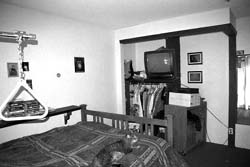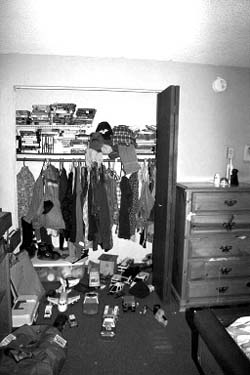 |
|
DHS
home | People with disabilities | Publications & data | Design
for Safety | Bedrooms
Design considerations for bedrooms
Worksite
Redesign Technical Advisory Project
Design configurations
and details of bedrooms must address the specific needs of the individual
residents. Personal belongings,
appliances, aids, and equipment necessary for treatment and therapy
should be considered. Any equipment not safely stored in this
area must be planned for and safely accommodated elsewhere
in the home.
Throw rugs are discouraged, as they are tripping hazards.Provide
for:
- Access to both sides of the bed where lifting is required
- Clear paths to all egress points (door and window)
- Closet threshold with the lowest profile possible
- Non-skid, beveled-edge rugs. They provide for easy resident mobility, and
resident and staff safety
- Adequate task lighting for procedures done in the bedroom
- Window coverings for light suppression and privacy
- Height-adjustable bed and positioners
- Built-in storage and dressers to allow clear floor space for
maneuverability
- Bedroom assignment made based on space requirements of the
resident.
Group home bedroom environments often have design requirements
well beyond those of a standard bedroom use. For mobility-impaired residents,
adequate room for turning, transfer and equipment must be considered. Additionally,
space for caregivers to provide assistance at the bed
may be required.
In order to maintain a clear path to all points of egress,
personal belongings, bed length and storage must be carefully arranged. Wheeled
beds must be of adequate height. Built-in closets and dressers in
alcoves help free floor space for moving and turning.
Upholstery and floor coverings should be selected to anticipate resident
needs. Carpets soften noise and provide warmth and a "homey" ambiance,
but increase friction and resistance on wheels and are difficult to sanitize.
In situations where incontinence is an issue or residents spend a good deal
of time on the floor, sheet vinyl or VCT (vinyl
composition tile) might be a better choice.
Area rugs or mats need
to be non-skid backed, kept flat, and cleaned frequently.
Good overhead lighting for the bedroom and closet is a necessity. There may be
additional specific lighting needs-low wattage or adjustable
lighting used when checking on a sleeping resident, for example.
Task lighting should be positioned where tasks occur.
For residents with
slow evacuation response, doors opening directly to the outside should
be considered. It is generally recommended that
residents be able to evacuate to a "safe zone".
Alternatives
to freestanding nightstands should be considered because of the tendency
to collect clutter and restrict access to the resident
and needed equipment.Design closet package with resident capabilities.
Return to top
Return to table of contents

River Road

River Road
|
Model Bedroom
- Provide good natural light and ventilation. General lighting in
each room, as well as at closets and task lighting areas all need
to be planned for
- Use built-in storage and dresser rather than furniture pieces where
possible to keep floor space open for maneu
verability
- Design to support resident choice and independence
- Generally choose curtains over doors for closets, regardless of
operation
- Blinds with cords are not recommended because they present a hazard
- Floor covering must be appropriate for needs
- Fiberglass-reinforced plastic wall paneling resists damage
- Keep all egress paths open
- Allow for light suppression and privacy with window coverings
- Beds should be placed in rooms of adequate size to permit access
to both sides of bed
- Beds and positioners should be evaluated in the context of work
needing to be done and room size
- Provide toe-space for safe lifting posture
- Tear-away curtain can be used as an alternative window covering
|
|
|
 Tear-away curtain Tear-away curtain 
- Clear paths must be maintained to all egress points
- Bedrooms should not be used for storage of equipment haphazardly
- A sliding door to the outside is a good life safety feature
(except when the path is blocked)
|

Sandy Street
|
- Rod height should be adjusted to fit user ability
- Positioning stander stored vertically at the edge of a room
does not restrict floor use
- Room is large enough to meet resident and caregiver needs
when appropriate equipment and design techniques are used
|

Santa Clara Avenue
|

Santa Clara Avenue |
- Room space could be improved with dresser furniture built
into the closet
- Additional shelving to contain personal belongings would
keep the floor clear of "tangle foot" hazards
|

High Street |
- Recessed storage needed instead of furniture to maximize
usable interior space
- Full operation of door is restricted by improper storage
- Objects placed precariously (such as the fan) pose a hazard
|
Return to top
Return to table of contents
- Shelving and organized spaces keep floors open for maneuverability
- Paths to doorways are clean and open
- Vinyl flooring is a good choice for a resident using a wheelchair
- Single overhead light, but windows provide good natural
light and ventilation
|

Sandy Drive |
- Night stand in the entry path is overloaded, and both the
stand and the contents are unstable
- Built-in headboard is an alternative for storage
|

High Street |

Martha Court |
- Items stored on nightstands or small tables need to be secured.
Keep electrical cords away from traffic areas
- Storage in this room is organized to keep floor space open
for maneuverability
- Provide sufficient and appropriate electrical outlets
|

Martha Court |
- Egress to outside provided by a sliding door
- Provide recessed storage shelves instead of using furniture
for storage. Such changes improve the usable interior space
for maneuverability
- Entertainment equipment is wall-mounted and out of the way
|
Return to top
Return to table of contents

Sandy Drive |
- A typical sliding door width of 34" will not
accommodate a bed egress
- Standard hardware and sliding doors are often difficult
to operate in an emergency
- Keep all paths and walks clear
|
|

Adelle |
- When egress is the primary use, doors should swing
outward
- Double door provides
egress for the bed if needed
- Shelf system can help keep belongings organized and
the room open
- A 6' slider does not provide 3' opening for egress,
while a 6'
french door provides 69"
|

Good Egress

Bad Egress
|
|

Santa Clara Avenue |
- Placing the bed in the alcove opens the room up for other
activities
- Inadequate space for bed changing promotes back strain
|

High Street |
- Bathroom used as bedroom storage illustrates the problem
of inadequate room space
- Equipment stored in the bedroom leaves little or no room
left for personal belongings
- Assessment of resident storage needs must influence design
|

Martha Court |
- Storage of personal belongings must be addressed
- Resident and staff safety is jeopardized by clutter, floor
obstruction, small wheeled toys and unstable stacked items
on shelves
- Open shelving, tape and CD organizers, and regular clean-up
are important remedies
|
Return to top
Return to table of contents
|
 Tear-away curtain
Tear-away curtain 


















